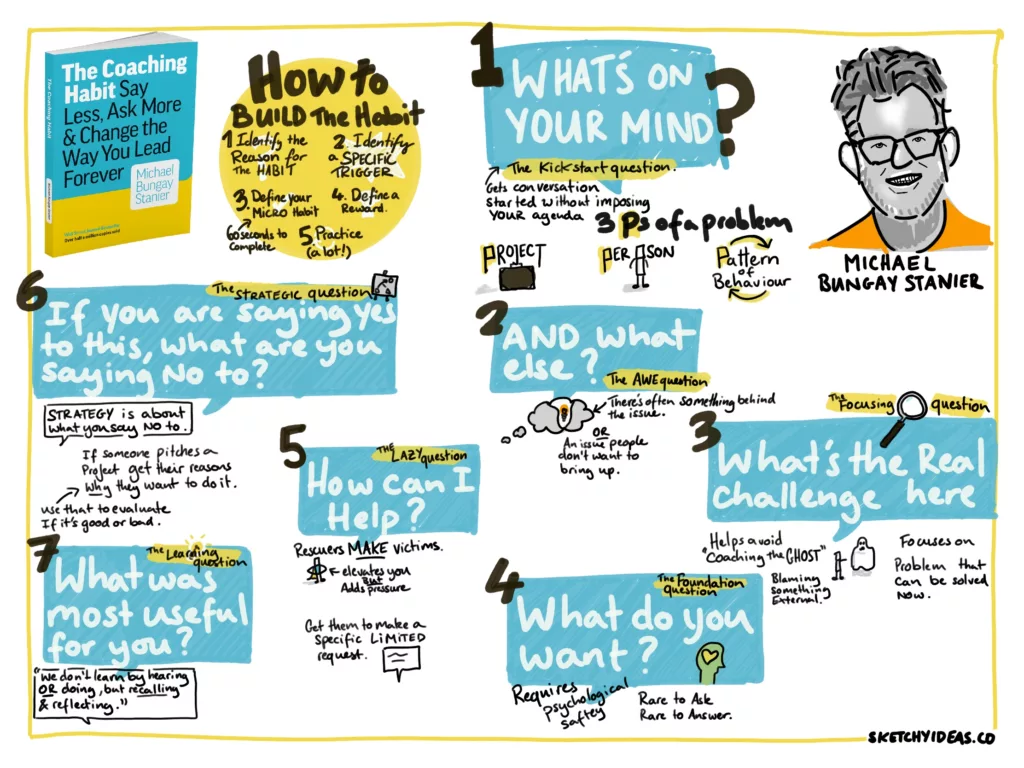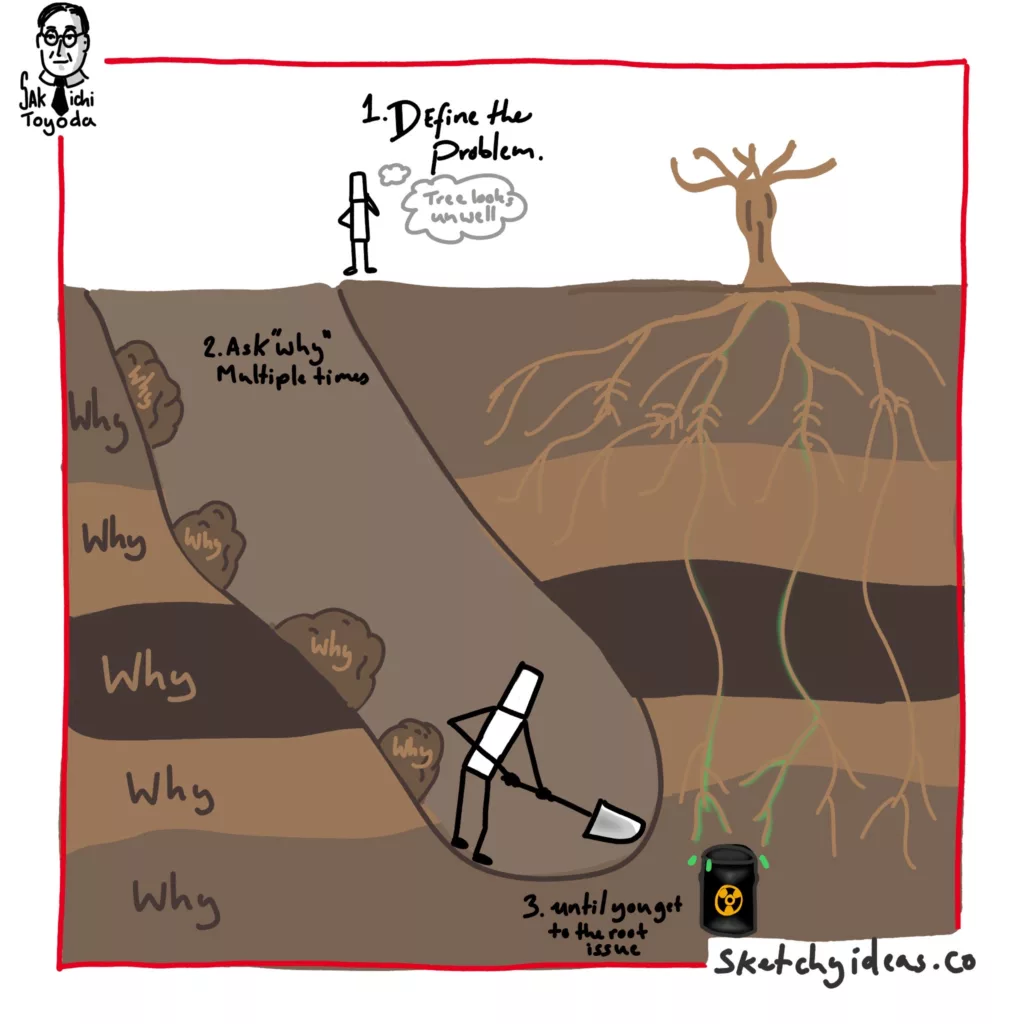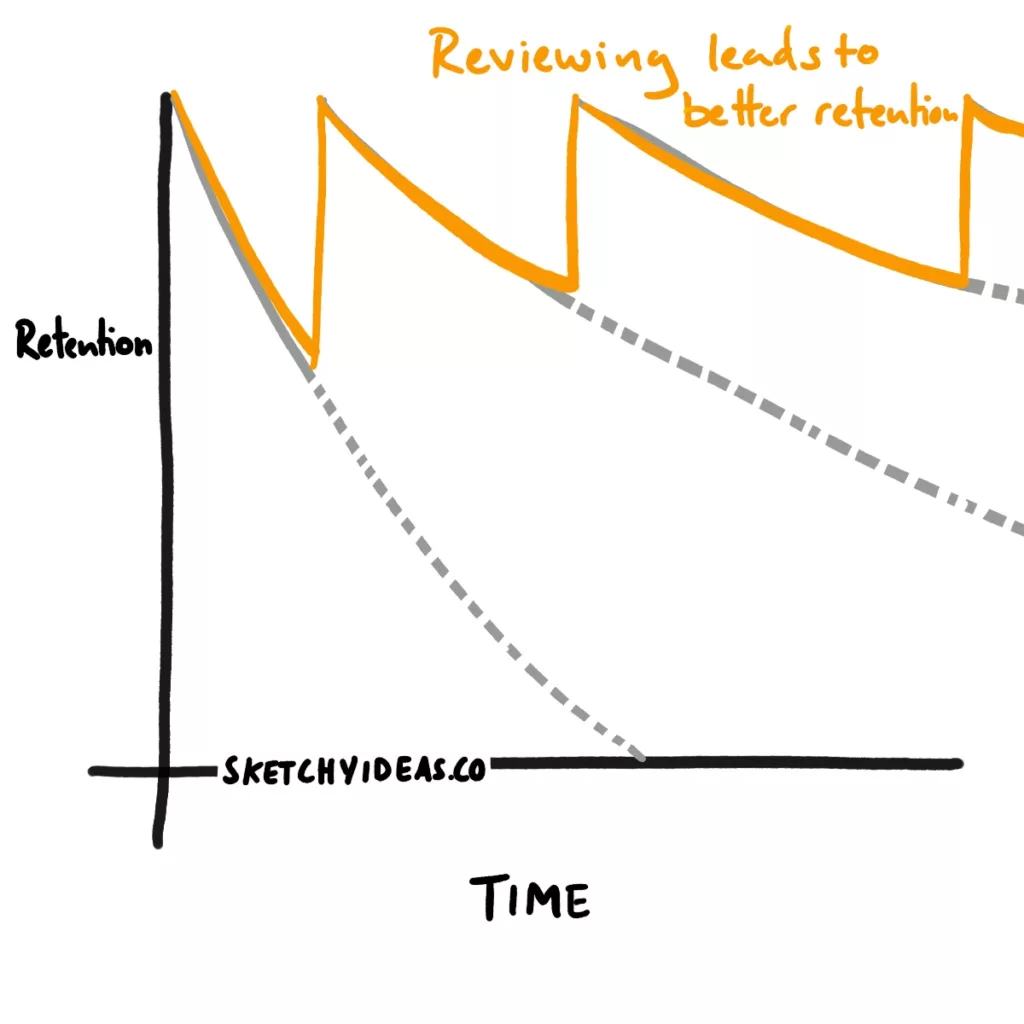I wish I had read this book 5 years ago.
I had become a manager and fell into the usual traps. While I know I wasn’t the worst and I did some things well, I eventually burned out as I didn’t empower the people I supervised well.
The Coaching Habit is a book that helps new and experienced managers introduce more coaching into their management.
The Coaching Habit Sketchnote Summary

The Main Problem with Most Managers
The biggest problem managers face is by jumping into giving advice or telling people what to do.
There’s a place for advice, but taking more time to coach by listening and asking questions, we empower our reportees and gain their unique insights.
So why don’t more managers do it?
There are three common reasons.
How to build The Coaching Habit
Michal Bungay Stainer draws on the research of Charles Duhigg in the power of habit to help readers work out how to add more coaching into their management.
The five steps are
- Identify the reason for the habit — this will give you the motivation to adopt it.
- Identify a specific trigger — this should be an existing trigger that makes you do the behaviour you want to change.
- Define your micro habit — this should be a sub-60 second action that will lead to the other actions and results you want.
- Define a reward — the reward will make you want to do your habit and keep you going.
- Practice a lot! — habits take time to build, you’ll need to invest willpower at the start.
Now you’re ready to learn the questions to incorporate into your management practice.
The Seven Coaching Habit Questions
The following questions are guidelines for how you give less advice, and help more. The order is important, but it’s
The kickstart question: What’s on your mind?
This question gets past small talk and helps bring out what someone needs help with.
But the biggest difference is starting with them and their issues not you and your issues. Managers usually want to discuss a problem or new task, but by starting with that, we can miss problems and opportunities that others see.
Plus asking the reportee gives them agency which is more motivating.
The 3 Ps of problems
There are three main causes of problems for people.
- Projects – the thing you are working on is challenging.
- People – the people you are working with are a challenge
- Patterns of behaviour – the way we do things is a challenge
There can be other issues, but most will come back to one of these three things so look out for them.
The AWE question: And what else?
Even when we ask people what they want to talk about, they may not bring it up straight away.
And even when they do, they may not be conscious of the issues they want to talk about. Asking “and what else?” helps them go deeper by prompting and giving permission.
This is similar to the five whys technique.

The focus question: What is the real challenge for you here?
It may happen quickly or take a bit of time, but soon there will be several things on the table.
But there’s probably one or two issues that underlie everything. The focusing question helps narrow down on the issue that needs addressing today.
The additions are important.
- Real – helps get at the foundational issue
- For you – helps avoiding abstracting and blaming others
- Here – helps focus on the here and now.
All of which help identify issues that can be addressed.
The foundation question: What do you want?
Even when we know the issue, we still need to know what outcome we want.
It’s incredibly rare for someone to ask what you want and even rarer for someone to answer it! And yet that’s why it’s so powerful. An adult relationship is where we can say what we want, and be okay if we can’t get it.
When we know what the problem is, and the outcome we want, we can
The lazy question: How can I help?
For many managers, this is the starting point — but it causes the helpers paradox.
By “helping” we elevate ourselves and not the person we help. While this can be the right thing to do, especially when they don’t have access or power to do certain functions, it’s a bad default.
By asking after all the previous questions, we can help them identify the real issues and what needs to be done. Often that is enough for them to take action rather than us.
And when they do need our help, it will be a real need.
The Strategic Question: If you say yes to this, what are you saying no to?
“Strategy is about what you say no to.”
It’s easy to overcommit. Adding one extra 15-minute task might not seem like a lot, but once you add 4 of them, that’s an hour gone. (And that’s assuming they actually do last only an hour which is unlikely.)
So instead of adding something more, think replacing something worse.
But don’t jump to a decision based purely on your own judgement — ask why they think it would be a good project to do.
They might show a long-term benefit you haven’t considered. Or they may be more motivated to attack that task which is likely to lead to better work.
Even when you make the same decision, they will feel herd and you may find another opportunity to deal with those same goals and desires.
The learning question: What are you taking away from this?
We don’t learn by being told or even by doing, but by recalling and reflecting.
That’s why this question matters. It’s not just enough to decide what to do, but to look back and reflect on what they learned in the process. Perhaps it was realising that the real problem wasn’t their colleague’s feedback, but how they react to it. Or maybe it was realising that the project brief lacked the details they need (and it’s a common occurrence).

By taking a moment to reflect, we can insure it’s not forgotten.
Speaking of learning, you might like to check out this series of visual to help you learn more.
Get your own copy of The Coaching Habit
If this book summary has whet your appetite, you should grab your own copy of the book. There are more details including other strategic questions you can ask, and how to make learning stick.
Plus practical ideas for how to implement each question.

Leave a Reply